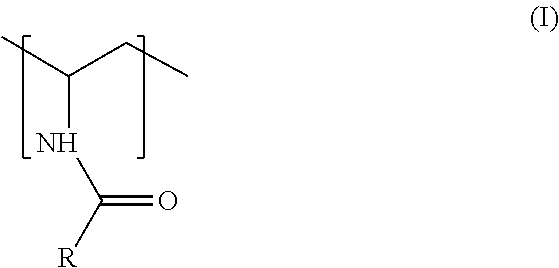Process to produce an acylated vinylamine-containing polymer and its application as a papermaking additive
a technology of acylated vinylamine and polymer, which is applied in the field of preparing acylated vinylaminecontaining polymers, can solve the problems of high cost and commercially unavailable industrial production of monomers, and achieve the effects of improving paper and paperboard dry strength, accelerating pulp fiber drainage, and increasing fine retention
- Summary
- Abstract
- Description
- Claims
- Application Information
AI Technical Summary
Benefits of technology
Problems solved by technology
Method used
Image
Examples
example 1
Preparation of Acetylated (24.7 mol %) Poly(vinylamine) at a Controlled pH
[0056]A poly(vinylamine) solution (14.9% active polymer, 322.7 g) in a 1 L reaction flask was neutralized to pH 9.0 using 36.5% HCl. Acetic anhydride (Aldrich Chemical Co., 16.9 g, 24.7 mol % based on the amine content of the poly(vinylamine)) was added over 10 minutes with stirring at a temperature in the range of from 30° C. to 40° C. while the pH was maintained at 9.0 using a NaOH solution. The resulting mixture was stirred at a temperature in the range of from 30° C. to 40° C. for 30 minutes and the pH was kept at 9.0 using a NaOH solution. After no further change in the reaction pH, the reactant was cooled to room temperature and the pH was adjusted to 7.5 using 36.5% HCl to give the final clear solution product with total solids of 25.5% and the active polymer of 14.2% as calculated. The charge density was measured to be 6.74 meq / g at pH 7.0. The product is a transparent solution with a Brookfield viscos...
example 2
Preparation of Acetylated (24.6 mol %) Poly(vinylamine) Without pH Control
[0057]A poly(vinylamine) solution (14.9% active polymer, 600.0 g) in a 2-L reaction flask was neutralized to pH 10.0 using 36.5% HCl. Acetic anhydride (Aldrich Chemical Co., 31.3 g, 24.4 mol % based on the amine content of the poly(vinylamine)) was added over 10 minutes with stirring at a temperature in the range of from 30° C. to 40° C. For this example, the theoretical amine content of the PVAm is 14.9%×600 / 71.08=1.258 mole; acetic anhydride is 31.3 / 102.09=0.307 mole; therefore the mole percentage is 0.307 / 1.258=24.4 mol %. The resulting mixture was stirred at a temperature in the range of from 30° C. to 40° C. for 30 minutes and the pH decreased to 8.0. After no further decrease in the reaction pH, the reactant was cooled down without further pH adjustment to give the final product with total solids of 27.0% and the active polymer of 14.7% as calculated. The charge density measured to be 6.82 meq / g at pH 7....
examples 3 through 15
[0058]Examples 3 to Example 15 were prepared as described in Example 2 except that different mol % of acetic anhydride were used in acetylation and that the reaction started at different pH. All the solution products were transparent in appearance.
[0059]
TABLE IPreparation of Acetylated Poly(vinylamine) with Different mol %of Acetic AnhydrideAceticanhydrideActiveVis-CDmol % / PVAmStartingEndingSolidscosity(meq / aminepHpH%cpsg)Example 37.710.59.014.61824Example 414.410.58.611.65657.65Example 520.810.58.511.9540Example 623.210.58.314.61824Example 724.511.29.114.012966.82Example 825.810.58.114.917126.60Example 927.110.57.913.01504Example 1028.511.28.913.315566.15Example 1129.911.28.613.61624Example 1231.311.28.513.718605.78Example 1334.311.57.312.56245.12Example 1437.511.56.612.26164.51Example 1544.511.5—12.8756
PUM
| Property | Measurement | Unit |
|---|---|---|
| temperatures | aaaaa | aaaaa |
| molecular weight | aaaaa | aaaaa |
| temperature | aaaaa | aaaaa |
Abstract
Description
Claims
Application Information
 Login to View More
Login to View More - R&D
- Intellectual Property
- Life Sciences
- Materials
- Tech Scout
- Unparalleled Data Quality
- Higher Quality Content
- 60% Fewer Hallucinations
Browse by: Latest US Patents, China's latest patents, Technical Efficacy Thesaurus, Application Domain, Technology Topic, Popular Technical Reports.
© 2025 PatSnap. All rights reserved.Legal|Privacy policy|Modern Slavery Act Transparency Statement|Sitemap|About US| Contact US: help@patsnap.com

